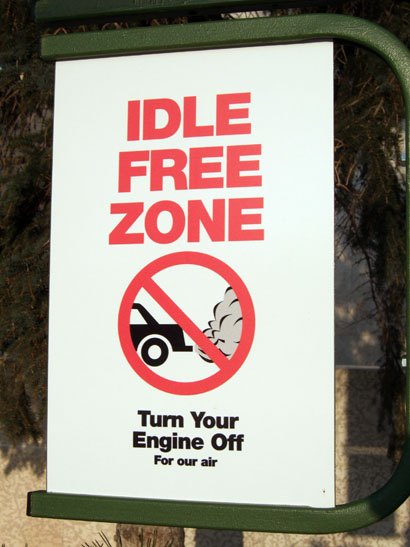Damn The EPA: Mazda Makes All Cars Idle Free

By 2015, no new car made by Mazda will stand around idle. By this year, Mazda plans to install its idling stop function on all of its new automobiles, says today’s Nikkei [sub]. Some domestic and European Mazda already have this feature. In a few years, it will be universal, including North America, where current EPA regulations discourage idle stop.
Minivehicles, which Mazda sources from Suzuki, will remain an exception.
This will not be your father’s idling stop. It’s an idling stop with brains. (Not that I’m saying your father has no brains…) The Mazda idling stop has sensors in the engine that specify which cylinder will get the first spark after the vehicle had stopped. By picking the piston with the optimal position in the cylinder, Mazda shortened the time to restart to a third of a second.
Mazda will introduce a new direct fuel injection engine in 2011. The new engine will improve fuel economy by 15 percent in gasoline models and by 20 percent in diesel models. With idle stop added, Mazdas will be even more fuel frugal. Mazda aims to improve average fuel economy by 30 percent come 2015. Their opposition is hybrid cars. Mazda plans to beat them with an improved ICE, in fuel consumption and especially in driveability.

Bertel Schmitt comes back to journalism after taking a 35 year break in advertising and marketing. He ran and owned advertising agencies in Duesseldorf, Germany, and New York City. Volkswagen A.G. was Bertel's most important corporate account. Schmitt's advertising and marketing career touched many corners of the industry with a special focus on automotive products and services. Since 2004, he lives in Japan and China with his wife <a href="http://www.tomokoandbertel.com"> Tomoko </a>. Bertel Schmitt is a founding board member of the <a href="http://www.offshoresuperseries.com"> Offshore Super Series </a>, an American offshore powerboat racing organization. He is co-owner of the racing team Typhoon.
More by Bertel Schmitt


































Comments
Join the conversation
>>>where current EPA regulations disincentivize idle stop. Bertel, I don't think "disincentivize" is a verb, or even a word. How about "discourage"?
Equipping a turbo-diesel with a start-stop won't necessarily endanger the turbos... if you're stopped at a stoplight with the engine off for thirty seconds, it doesn't give the oil time to coke. And safeguards can be programmed into this... safeguards that will leave the engine on if oil temperature is above a certain amount. I don't see why people are so against idle-stop (as long as it's programmed properly)... when I'm sitting in traffic and it's not too hot or too cold, I turn my engine off if I know I'm going to be waiting for longer than thirty seconds. Saves you lots of gas. Make this automatic and combine with a system that either doesn't use a starter or uses a high-speed (2000+ rpm) starter, and extra wear and tear is negligible. That said, engines hate to idle... they're outside their optimum efficiency range, they're generating more heat inside an engine bay that doesn't have 50 mph air going through the radiator and they're using gas needlessly. It's just like open-loop engine mapping... you don't need to run your engine with tons of timing advance and a rich air-fuel mixture when you're cruising at part throttle on the highway... that's just a waste of gas. And just like that fuel-saving, emissions friendly feature, a stop-start system won't interfere with your driving pleasure when you're actually mashing the pedal and carving up the road.
If I'm wrong, I trust that any TTAC readers will set me straight but: The crankshaft is spinning on a thin coating of pressurized oil over the main bearings when it's running. When the engine stops running, the bearings are no longer lubricated and the crankshaft bearings are now resting on the main bearing itself. When the engine starts again, there is a small amount of wear on both sets of bearings due to the metal to metal contact and the high points of unworn metal being sheared off. I read in 'Drive It Forever' by Robert Sikorsky that starting your car puts the same amount of wear on your engine as 500 miles of highway driving. Now, take the effect of being bumped backwards over the bearings by the initial spark to pump up the compression and then running forward after the start which will again create wear before the oil pressurizes. Wouldn't this double the wear of a normal restart as per my example? If a car is mostly driven in the city, what kind of wear happens? How long before the crankshaft is out of tolerance? How much for a rebuild? I think this is a bad idea, much along the lines of the Caddy V-8-6-4, which was also implemented to save fuel. You want to save fuel and still have power? Then make engines smaller and add supercharging AND turbocharging! Or use a small diesel as a charging device for a bank of batteries and drive the wheels using electric motors.
A modern and well designed start / stop system has little bearing on longevity of the engine. Those concerns are unfounded. It's benefits can be quite large. It is a little unnerving when the engine shuts off at a stop - but it will restart immediately when you are ready to go. Minor problems is when you have the a/c on and whether it stays on (i.e. electrically driven and no longer dependent on engine running). Or car just cycles already conditioned air through cabin and a/c is off until the car is moving again and engine is fully running.